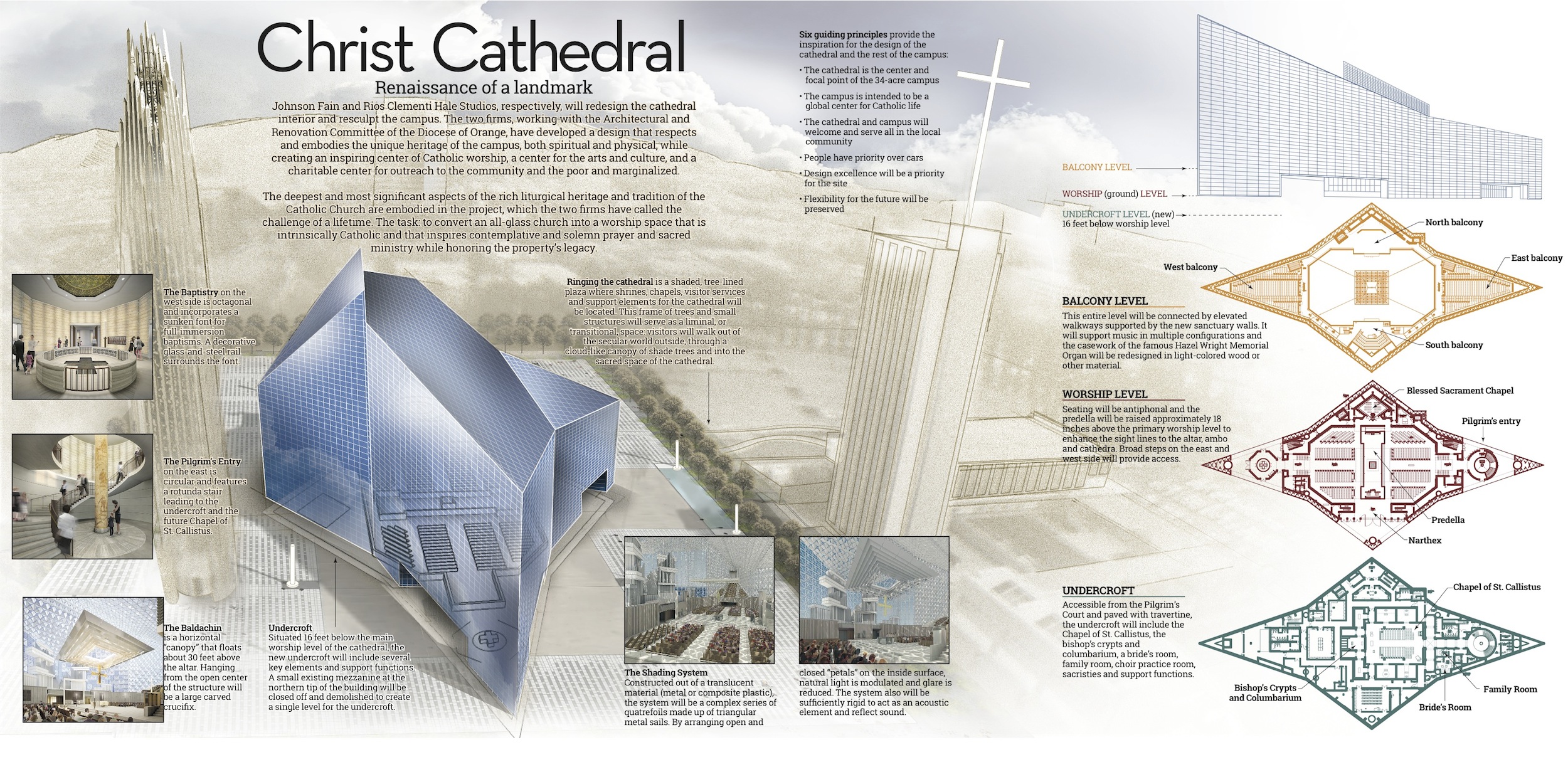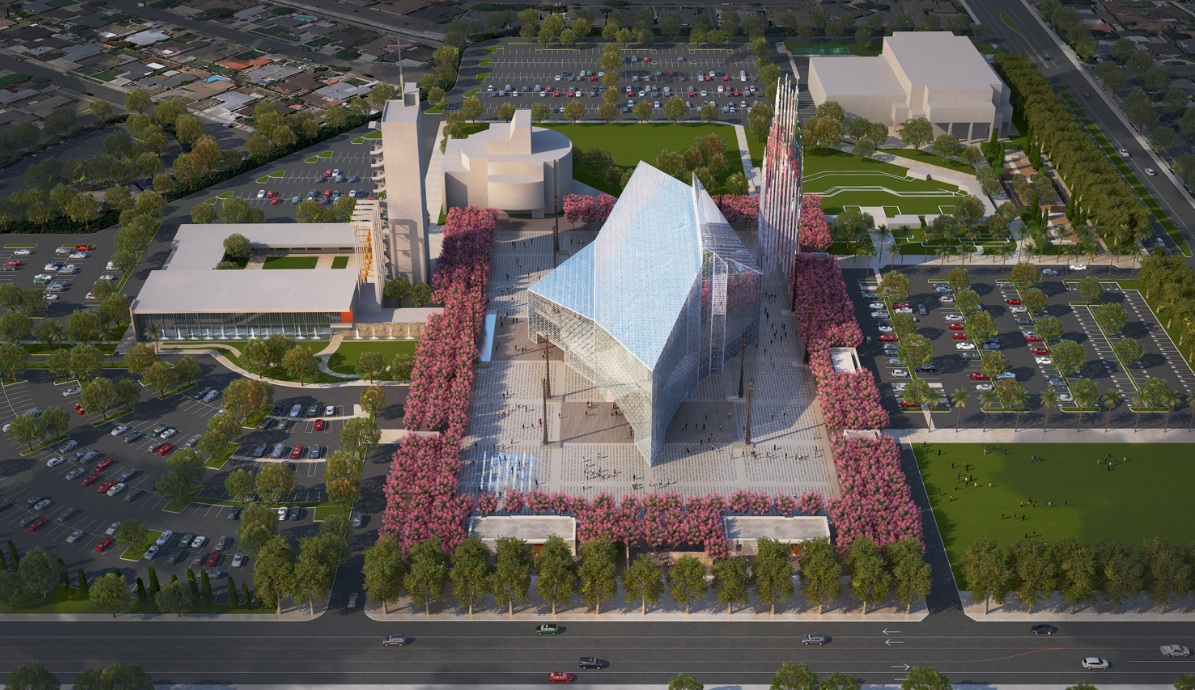The Roman Catholic Diocese of Orange has two retained architectural firms, Johnson Fain (with a focus on the Cathedral building itself) and Rios Clementi Hale Studios (with a focus on the exterior spaces), to create a design plan that addresses the complex needs of the 1.3-million-member diocese and the day-to-day needs of a more than 10,000-member Cathedral parish.
In addition to addressing these pressing needs, the design committee was tasked to develop a multifaceted plan that not only addressed the complex design requirements of transforming the Christ Cathedral into a space that is both liturgically and intrinsically Catholic, but also addresses a variety of intricate engineering challenges to bring the building and its grounds to the cutting-edge with regard to technology and site usability.
Within the interior of the cathedral the design ethic conserves and revitalizes the excellent and inspirational architecture that exists while transforming the space into one that supports the liturgical aspects of the Catholic faith and the centrality of the Eucharist.
The exterior design of the site works to create a structure and theme commensurate with the dynamism and beauty of the existing structures. This new landscape and the new spaces that will be created honor the history of the site, its architecture, and its worshippers while also enabling its renewed life as a Roman Catholic cathedral.
The design reinforces the liturgical importance of the cathedral building in relation to the adjacent buildings and welcomes pilgrims into an experience of faith as they enter the campus and cathedral.
PEDALS OF LIGHT
The design team confronted several dynamic challenges throughout this process unique to creating a Catholic cathedral that supports a solemn and prayerful experience from an existing structure. Given the glass façade of the cathedral, heat transfer, excess light, and acoustics presented a significant challenge. To address this, the design team developed an innovative treatment to be installed on the ceiling of the cathedral. The proposed treatment will be composed of a series of four rigid "petals" that cover each of the more than 10,000 panes of glass, opening between 15 and 45 degrees.
These petals will not only control light and heat transfer, but will assist with the acoustic properties of the space. The placement and aperture of the petals was a result of analyzing the sun's path of travel across the building's façade, an analysis of existing acoustic reverberation times and a careful study of how new lighting can be coordinated to cover the large and tall volume.
Additionally, the placement of the altar, the center point of the Catholic Mass, presented a challenge given the nearly one million cubic feet of space and the visually arresting Hazel Wright Organ, the fourth largest within a Church in the world. The liturgical experts and design team addressed this issue by drawing inspiration from the historical tradition of the Church. One of the oldest forms of a Catholic Church is an antiphonal layout, with the altar at the center of the space, with congregants on either side. This layout and altar placement allows for the maximum use of the space while ensuring the altar is truly the center point of focus within the cathedral.
This ambitious project has been divided into two phases of work: phase one will address itself to the worship level of the cathedral, major infrastructure elements, the cathedral courtyard and a reflection garden that will house the existing campus statuary and beautiful replicas of the more than 1800 "Walk of Faith" stones currently throughout the campus. Phase two will include an expansion of the Cathedral Memorial Gardens Cemetery, the undercroft, or lower level of the cathedral, and the remainder of the Master Plan for the campus grounds.
There is a $29 million allocation from the $100 million For Christ Forever capital campaign to support phase one of this project. Additional funding is being raised for this development plan through a long-planned "leadership gift" phase of the capital campaign.
HISTORY OF CHRIST CATHEDRAL
In the late 1970s, legendary American architect Philip Johnson and his partner John Burgee presented their designs for an "all-glass church" to Reverend Robert Schuller. Upon seeing the plans, Reverend Schuller exclaimed, "Wow, it looks like a crystal cathedral!" The building was a massive undertaking, taking over two years to complete. Standing 120 feet tall (12 stories), 141 feet long and 207 feet wide, this 78,397-square-foot edifice is constructed entirely of glass and steel.
With more than 10,000 panes of mirrored glass, the cathedral structure is known the world over for its inspiring beauty and breathtaking scale. The main sanctuary seats more than 2,000 people and will become a spiritual home to Orange County's more than 1.3 million Catholics. The cathedral has closed for an extensive renovation to remake the space as a place of Catholic worship and will reopen after its formal dedication in 2017.
Related Stories
Architects | Feb 5, 2021
Heartwell named CEO at CallisonRTKL; Thompson appointed firm's first COO
Kim Heartwell named CEO at CallisonRTKL; Harold Thompson appointed COO.
Healthcare Facilities | Feb 5, 2021
Healthcare design in a post-COVID world
COVID-19’s spread exposed cracks in the healthcare sector, but also opportunities in this sector for AEC firms.
Building Owners | Feb 4, 2021
The Weekly show, Feb 4, 2021: The rise of healthy buildings and human performance
This week on The Weekly show, BD+C editors speak with AEC industry leaders from Brookfield Properties, NBBJ, and UL about healthy buildings certification and improving human performance through research-based design.
AEC Tech | Jan 28, 2021
The Weekly show, Jan 28, 2021: Generative design tools for feasibility studies, and landscape design trends in the built environment
This week on The Weekly show, BD+C editors speak with AEC industry leaders from Studio-MLA and TestFit about landscape design trends in the built environment, and how AEC teams and real estate developers can improve real estate feasibility studies with real-time generative design.
Multifamily Housing | Jan 27, 2021
2021 multifamily housing outlook: Dallas, Miami, D.C., will lead apartment completions
In its latest outlook report for the multifamily rental market, Yardi Matrix outlined several reasons for hope for a solid recovery for the multifamily housing sector in 2021, especially during the second half of the year.
Modular Building | Jan 26, 2021
Offsite manufacturing startup iBUILT positions itself to reduce commercial developers’ risks
iBUILT plans to double its production capacity this year, and usher in more technology and automation to the delivery process.
Architects | Jan 26, 2021
Perkins&Will and AIA set stage for industry adoption of Justice, Equity, Diversity, and Inclusion (J.E.D.I) programs
A new white paper provides U.S. architecture firms with clear guidance on establishing just, equitable, diverse, and inclusive work cultures.
Data Centers | Jan 21, 2021
The Weekly show, Jan 21, 2021: Data centers in a pandemic world, and LGBT certification for AEC firms
This week on The Weekly show, BD+C editors speak with AEC industry leaders about LGBT certification for architecture, engineering, and construction firms, and the current state of data centers in a pandemic world.
Multifamily Housing | Jan 20, 2021
Abandoned Miami hospital gets third life as waterfront condo development
The 1920s King Cole Hotel becomes the Ritz-Carlton Residences Miami in the largest residential adaptive reuse project in South Florida.
Market Data | Jan 19, 2021
2021 construction forecast: Nonresidential building spending will drop 5.7%, bounce back in 2022
Healthcare and public safety are the only nonresidential construction sectors that will see growth in spending in 2021, according to AIA's 2021 Consensus Construction Forecast.


























